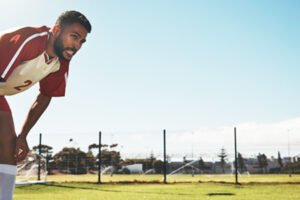
Football fitness does NOT improve players
Football training is, first of all, about improving the players’ ability to interact with the football environment. As explained in detail in previous blogs, these football (inter)actions consist of three phases: 1) Communication, 2) Decision making, and 3) Executing decisions. This CDE reference represents a player’s football ability. In football training, the main objective is to improve this football ability from 100% to 101%, i.e. ‘Better Football Actions’. For example, a player will learn to Communicate better, make better Decisions to pass, and improve their Execution of the decisions to pass.
Football ability versus Football fitness
Football ability allows players to perform the ‘Communication-Decision making-Executing decision’ cycle as good as possible. Next, players need the ability to repeat this cycle (CDE) as frequently as possible and for 90 minutes. This ability is what we call ‘football fitness’. So, first, you must be able to perform a football action once (football ability) before you can develop the ability to perform this action more frequently and for 90 minutes (football fitness). In other words, you must play football first before you can improve your fitness within that football context. This proves the point that football fitness does not exist and, therefore, cannot be improved outside the football context.
Football fitness does NOT improve players
Football ability and football fitness are two important components, but it is important to distinguish the two. Improving football ability means developing football (inter)actions from 100 to 101%. Improving football fitness means performing these football (inter)actions at 100% more frequently and for longer.
In other words, during football fitness training a player is not developing his football ability from 100 to 101%. Therefore, football fitness does not improve players.
The emphasis during football fitness training is on reproducing the current 100% football ability as frequently as possible and for as long as possible based on the three football fitness characteristics: 1) More Football Actions, 2) Maintain Good Football Actions, and 3) Maintain Many Football Actions.
More 100% Football Actions per minute
With the football fitness characteristic ‘More Football Actions’ it is all about the ability to perform a football action at 100% more often per minute. This is very important in football, but this football fitness characteristic does not lead to a better football player. His football ability does not increase to 101%. He can only perform this ability more frequently. For example, a football ‘fitter’ player is able to perform an action at 100% not twice but three times in twenty seconds. This is important in football but has nothing to do with improving football ability.
Maintain 100% Football Actions
A player who is able to ‘Maintain Good Football Actions’ for a longer is a player who can perform actions at 100% for 90 minutes. This would be impressive, but it doesn’t mean that someone’s football ability has improved. This football fitness characteristic does not contribute to better Communication, Decision making and Execution of decisions. It allows a player to maintain his football ability for as long as possible.
Maintain Many 100% Football Actions
For the third football fitness characteristic ‘Maintain Many Football Actions’ the same applies as for the two previous characteristics. Increased football fitness is an important part of playing football, but it is not the same as improving the football ability. In this case, it concerns a player who is still able to Maintain Many Football Actions (at 100%) per minute in the final phase of the game and can, therefore, keep playing at a high tempo. This is another example of maintaining the football ability for 90 minutes which is something else than improving this ability.
Correcting thinking errors
Because the concept of ‘football fitness’ has been clearly defined in previous blogs, it is possible to put things into perspective and to expose and correct all kinds of thinking errors in football. ‘Better’ is something else than ‘more frequently’. ‘Quality’ is something other than ‘quantity’. That is not a game of words but a simple fact. That is why ‘More Football Actions’ should not be classified under ‘Better Football Actions’. ‘Better’ means from 100 to 101%. ‘More’ refers to the frequency of performing that 100%. The same goes for ‘Maintaining’. That too has nothing to do with ‘Better’ but with performing an ability for longer, i.e. more of the same.
Contributing to team performance
Hopefully, the above has made it clear that football ability and football fitness are not the same. The football ability says something about the quality of Communication, Decision making and Execution of decisions (CDE), i.e. how good you are as a player. Football fitness is the ability to perform CDE more frequently and for longer but has no influence on the absolute quality of either Communication, Decision making and Execution of decisions.
Nevertheless, football fitness is a crucial component of football. If player A and B have the same football ability, they are equally good players. However, if player A has a higher football fitness than player B, he will contribute more to the team performance during the game. In other words, the ability to Communicate, make Decisions and Execute decisions is exactly the same, but a team with more players like player A will be able to develop a higher tempo and to maintain the higher tempo for longer compared to a team with predominantly players like player B.
To summarize, football fitness does not improve football players and in particular their football ability, but it does improve the contribution of players to the team performance. Football fitness does not improve the INDIVIDUAL football ability of players but it does allow players to be better TEAM players.


